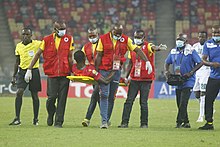
Physical therapy (PT), also known as physiotherapy, is a healthcare profession, as well as the care provided by physical therapists who promote, maintain, or restore health through patient education, physical intervention, disease prevention, and health promotion. Physical therapist is the term used for such professionals in the United States, and physiotherapist is the term used in many other countries.
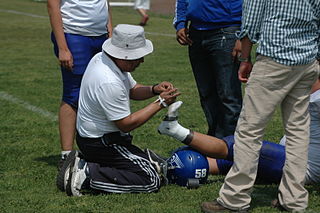
Sports injuries are injuries that occur during sport, athletic activities, or exercising. In the United States, there are approximately 30 million teenagers and children who participate in some form of organized sport. Of those, about three million athletes age 14 years and under experience a sports injury annually. According to a study performed at Stanford University, 21 percent of the injuries observed in elite college athletes caused the athlete to miss at least one day of sport, and approximately 77 percent of these injuries involved the knee, lower leg, ankle, or foot. In addition to those sport injuries, the leading cause of death related to sports injuries is traumatic head or neck occurrences.

A concussion, also known as a mild traumatic brain injury (mTBI), is a head injury that temporarily affects brain functioning. Symptoms may include loss of consciousness; memory loss; headaches; difficulty with thinking, concentration, or balance; nausea; blurred vision; dizziness; sleep disturbances, and mood changes. Any of these symptoms may begin immediately, or appear days after the injury. Concussion should be suspected if a person indirectly or directly hits their head and experiences any of the symptoms of concussion. Symptoms of a concussion may be delayed by 1–2 days after the accident. It is not unusual for symptoms to last 2 weeks in adults and 4 weeks in children. Fewer than 10% of sports-related concussions among children are associated with loss of consciousness.
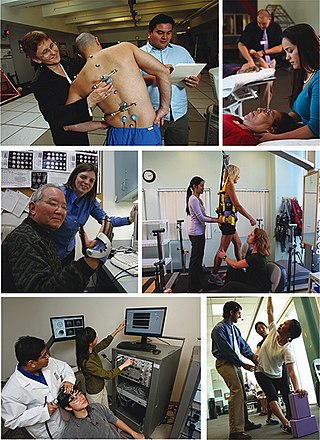
Kinesiology is the scientific study of human body movement. Kinesiology addresses physiological, anatomical, biomechanical, pathological, neuropsychological principles and mechanisms of movement. Applications of kinesiology to human health include biomechanics and orthopedics; strength and conditioning; sport psychology; motor control; skill acquisition and motor learning; methods of rehabilitation, such as physical and occupational therapy; and sport and exercise physiology. Studies of human and animal motion include measures from motion tracking systems, electrophysiology of muscle and brain activity, various methods for monitoring physiological function, and other behavioral and cognitive research techniques.
Jane S. Thornton is a Canadian Clinician Scientist, Olympic rower and international advocate for physical activity. She is the Canada Research Chair in Injury Prevention and Physical Activity for Health at the University of Western Ontario. She was born in Fredericton, New Brunswick.

The British Journal of Sports Medicine is a twice-monthly peer-reviewed medical journal covering sports science and sports medicine including sport physiotherapy. It is published by the BMJ Group. It was established in 1964 and the editor-in-chief from 2008 to 2020 was Karim M. Khan. Jonathan Drezner has been editor-in-chief since January 1, 2021.

Knee pain is pain in or around the knee.
Health issues of athletics concern the health and well-being of athletes who participate in an organized sport. If athletes are physically and mentally underdeveloped, they are susceptible to mental or physical problems. Athletes trying to improve their performance in sports can harm themselves by overtraining, adopting eating habits that damage them physically or psychologically, and using steroids or supplements.
Concussions, a type of mild traumatic brain injury, are a frequent concern for those playing sports, from children and teenagers to professional athletes. Repeated concussions are known to cause neurological disorders, particularly chronic traumatic encephalopathy (CTE), which in professional athletes has led to premature retirement, erratic behavior and even suicide. A sports-related concussion is defined as a "complex pathophysiological process affecting the brain, induced by biomechanical forces". Because concussions cannot be seen on X-rays or CT scans, attempts to prevent concussions have been difficult.
A traumatic brain injury (TBI) is a blow, jolt or penetration to the head that disrupts the function of the brain. Most TBIs are caused by falls, jumps, motor vehicle traffic crashes, being struck by a person or a blunt object, and assault. Student-athletes may be put at risk in school sports, creating concern about concussions and brain injury. A concussion can be caused by a direct blow to the head, or an indirect blow to the body that causes reactions in the brain. The result of a concussion is neurological impairment that may resolve spontaneously but may also have long-term consequences.
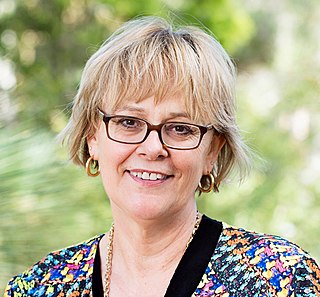
Caroline Finch AO is an Australian sports injury epidemiologist and sports injury prevention researcher. Her research has been adopted and used to directly inform safety policy by Government Departments of Sport and Health, health promotion and injury prevention agencies, and peak sports bodies both within Australia and internationally. Her injury prevention research has been applied to falls in older people, road safety, workplace safety and injuries in children.

The Australasian College of Sport and Exercise Physicians (ACSEP) is a not-for-profit professional organisation responsible for training, educating, and representing over 350 doctors in Australia and New Zealand. These doctors practise medicine in the specialty of sport and exercise medicine (SEM). The ACSEP is the smallest of the 15 recognised specialist medical Colleges in Australia with approximately 260 Fellows and Registrars in 2020. Australia and New Zealand, along with the UK, have been cited as pioneer countries in the establishment of SEM as a stand-alone specialty.
The Faculty of Sport and Exercise Medicine (UK) (FSEM) is a not-for-profit professional organisation responsible for training, educating and representing over 500 doctors in the United Kingdom. These doctors practise in the speciality of sport and exercise medicine (SEM). The FSEM is housed in the Royal College of Surgeons Edinburgh, but is an intercollegiate faculty of the Royal Colleges of Physicians and RCSEd

John Orchard FACSEP is an Australian sport and exercise medicine physician, notable for advocating for rule changes in sport to improve player safety. In 2020 he was awarded a Member of the Order of the Order of Australia for significant service to sports medicine, particularly cricket. He was a member of the Australian government advisory group for sport responding to COVID, representing professional sport as the Chief Medical Officer for Cricket Australia and was instrumental in cricket's response to COVID. During 2023, he worked as the General Medical Officer for Australia at the FIFA Women's World Cup.

Jonathan A. Drezner is an American sport and exercise medicine physician, currently editor in chief of the British Journal of Sports Medicine. In both clinical practice and research he has a strong interest in sports cardiology. He is a first author for the International Guidelines for Electrocardiography (ECG) Interpretation in athletes and was the 19th President of the American Medical Society for Sports Medicine (AMSSM) in 2012.
The American Medical Society for Sports Medicine (AMSSM) is a large sports medicine membership organization, representing over 3000 physicians in the United States, established in 1991. AMSSM includes members who serve as team physicians at the youth level, NCAA, NFL, MLB, NBA, WNBA, MLS, and NHL, as well as with Olympic and Paralympic teams.
A pediatric concussion, also known as pediatric mild traumatic brain injury (mTBI), is a head trauma that impacts the brain capacity. Concussion can affect functional, emotional, cognitive and physical factors and can occur in people of all ages. Symptoms following after the concussion vary and may include confusion, disorientation, lightheadedness, nausea, vomiting, blurred vision, loss of consciousness (LOC) and environment sensitivity. Concussion symptoms may vary based on the type, severity and location of the head injury. Concussion symptoms in infants, children, and adolescents often appear immediately after the injury, however, some symptoms may arise multiple days following the injury leading to a concussion. The majority of pediatric patients recover from the symptoms within one month following the injury. 10-30% of children and adolescents have a higher risk of a delayed recovery or of experiencing concussion symptoms that are persisting.
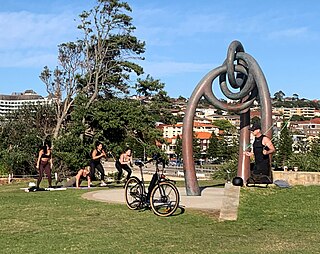
Exercise medicine is a branch of medicine that deals with physical fitness and the prevention and treatment of injuries and illness with exercise. In some countries, Sport and Exercise Medicine (SEM) is a recognized medical specialty. Exercise medicine is therefore an emerging physician (non-surgical) specialty, but there is also a belief that exercise is treatment of such fundamental benefit that it should be incorporated into all medical specialties. Allied health practitioners also can specialize in exercise such as exercise physiologists, physiotherapists, athletic trainers and podiatrists.

Carolyn Broderick is an Australian sport and exercise physician, who was the first female Australian Medical Director for an Australian Olympic team, and the Chief Medical Officer for Tennis Australia.
Michael Fredericson is an American academic and physician. He currently serves as a professor of orthopedic surgery and the director of Physical Medicine and Rehabilitation (PM&R) Sports Medicine within the Department of Orthopaedic Surgery at Stanford University. He is also the co-director of the Stanford Longevity Center.
